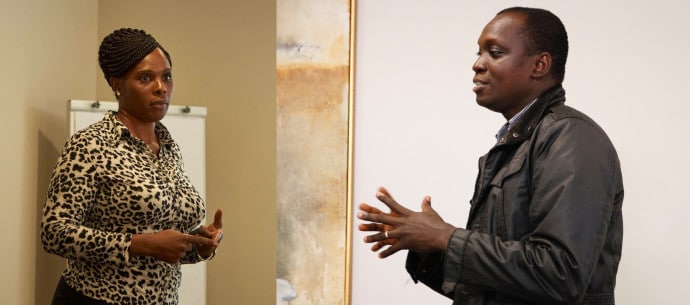“Opuntia engelmannii – the prickly cactus – is classified as an invasive alien species in Kenya,” said Eunice Githae of the Department of Biological Sciences, Chuka University, Kenya. “I want to fully understand its taxonomy, establish how it interacts with the environment and understand its socio-economic impact on rural communities in Kenya.”

“Invasive alien plant species are one of the major drivers of global ecosystem change and a serious threat to ecological, economic and social well-being,” she continued. “Their spread can damage livelihoods in rural areas by increasing poverty while simultaneously affecting biological diversity.”
Opuntia engelmannii, also known as the cactus apple, is originally from South America but on the African continent is specifically found in Kenya and South Africa. It is a species that spreads rapidly forming dense, impermeable thickets. It is extremely drought tolerant, adaptable to new environments and survives most threats.
“It therefore contributes to increased pressure on the diminishing pasture resources in Kenya,” said Githae. “This threatens pastoralists and agro pastoralists who are the main inhabitants of these lands.”
“To start there is a need to get the taxonomy right,” said Githae. “There are at least six different varieties, it has been known under different names and therefore the taxonomy has been controversial. It’s important to ensure that it is correctly classified because you can’t manage something you don’t know.”
“This study will aim to assess the socio-economic impacts of O. engelmannii on local livelihoods and their environment. I want to understand the local communities’ perceptions about the advantages and disadvantages of this cactus, specifically its impact on production, access and availability of forage in grazing areas, and the effects it has in displacing the indigenous vegetation cover.”
“It’s very important to work with the local communities,” added Githae. “They understand the biodiversity in the areas they live in and also fully understand the impact of changing biodiversity on their lives.”
“They can also provide very useful information on the success or failure of projects to manage such invasive species.”
The study will encompass literature reviews, a socio-economic survey and field work in order to provide holistic information that will be useful in ecosystem management, biodiversity conservation and improvement of human well-being.
“The study will aim to establish a baseline for Kenya as a starting point for more integrated management of this species,” said Githae. The Kenyan government has a national strategy and action plan for the management of invasive species in protected areas, which Githae will use as a guideline.
3D-printed houses as an option for Africa
What if 3D printers could be harnessed to retrofit Africa’s urban spaces to be more resilient to climate change?
This is the question that Patrick Cobbinah of the Department of Planning, Faculty of Built Environment, Kwame Nkrumah University of Science and Technology, Ghana, is considering.
“The news that a Chinese company successfully 3D printed ten houses in 24 hours rapidly, cheaply and with a bare-bones workforce offers a window into the future for sustainable development in Africa’s urban planning,” said Cobbinah. “Similar recent developments in Italy and The Netherlands make this possibility even stronger.”
“3D-printed houses that are affordable and adaptable to climate change could have a huge impact in Africa,” continued Cobbinah. “We are looking at a continent with an extremely high rate of urbanisation – urban planning is not keeping up; as at 2015 over half of urban populations in sub-Saharan African countries were living in slums.”
“African cities are resource-constrained environments with high levels of poverty, environmental degradation and pollution, and unchecked urban migration and expansion,” said Cobbinah. “Africa’s urban citizens are also extremely vulnerable to the projected impacts of climate change in the not-so-distant future.”
Cobbinah believes that in addition to cost, time and labour benefits, 3D printing of houses can take climate-change challenges into account by increasing resource efficiency, introducing novel structural designs to customise the architecture to the environment and even using recycled waste to build the houses.
“Ideally you would want to build ‘future-proof’ houses,” said Cobbinah.
“Fluctuations in climate have the potential to damage infrastructure in cities particularly low-cost structures in slums,” said Cobbinah. “The 3D-printed house in China was designed to withstand an earthquake with a magnitude of 8.”
“3D-printed houses would have the added advantage that they can be repaired fairly quickly in sections.”
“This project is specifically aiming to examine whether 3D printing of infrastructure is a possibility for assisting grassroots adaptation to climate change in Ghana’s urban-planning future. It will also try to understand the impact of the climate change-urbanisation interaction on sustainable development across different urban contexts and what urban planning policies/projects already exist that are directed towards resilience in housing for growing populations facing climate change.”
“We have to identify where slum communities are, the type of housing that already exists and the future climate-change possibilities (like flooding) so that we can propose the most appropriate type of 3D-printed housing for different areas.”
Cobbinah emphasised that: “It will also be very important to understand the cultural and acceptability issues – understanding what end products would be acceptable to local communities and giving people choices is vital. We have to introduce these concepts to local communities and get their opinions on the type of housing they want. So there are technology aspects, urban planning aspects and cultural aspects.”
Michelle Galloway: Part-time media officer at STIAS
